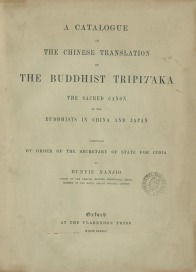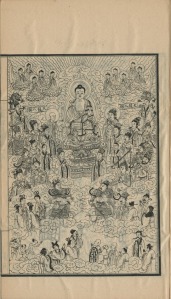In April 2013 I visited China with Joshua Seufert, who had been appointed in the summer of 2012 to take over most of my responsibilities in the Bodleian so that I could concentrate on cataloguing our pre-modern collections in my final years of employment.
We had a very enjoyable and productive time visiting suppliers of both printed books and digital resources, mostly in Peking and Shanghai. For two days we parted company. While Joshua pursued his own interests in Hangzhou, I took the opportunity of pursuing mine in Nanking to see two places which over the years had excited my curiosity.
The first was the Nanjing Massacre Memorial Hall 侵华日军南京大屠杀遇难同胞纪念馆, which presents a large and detailed exposition of the atrocities committed by Japanese troops in the weeks following their occupation of Nanking on 13 December 1937; the second was the subject of this blog entry, the Jinling Buddhist Press 金陵刻經處, whose name is sometimes translated as “Jinling Scriptural Press”.
If there is a connection between these two places, it is because they represent both the highest and the lowest points in the relationship between China and Japan.
I first became aware of Jinling Buddhist Press when cataloguing the following work in our collection:
解深密經 五卷 / (唐釋)玄奘譯
清同治十年[1871]金陵刻經處刊本
線裝1冊 ; 24公分
Sinica 2536
I had never heard of the publisher, and at the time was not particularly interested in making further investigations – I had several thousand editions to identify and could scarcely pursue scholarly research on each of them. Only when I came across a further ten editions in our collections by the same publisher, together with other Buddhist works printed in identical (or very similar) format by similarly named publishers, was my curiosity aroused.
The Press was founded by Yang Wenhui 楊文會 (1837-1911, 字仁山), who had converted to Buddhism after reading the “Awakening of faith” sutra (大乘起信論) on his recovery from a serious illness in 1864. He moved to Nanking in 1866 to work on the reconstruction of the city, which had been seriously damaged during the Taiping Rebellion. The Taipings had also been responsible for the destruction of the printing blocks of the Jiaxing Tripitaka 嘉興方冊大藏經.
Yang believed that the Buddhist faith, and through it the salvation of mankind, could only be revived through the reprinting and distribution of authoritative editions of its scriptures. So together with a group of like-minded friends, he established the Jinling Buddhist Press in 1866, and in that year its first publication was printed: Jingtu sijing 淨土四經, a collection of four sutras of the Pure Land school.
Like the Jiaxing Tripitaka, the Jinling editions were presented in thread-bound format (xianzhuang 線裝) rather than the folded binding (zhezhuang 折裝) of the imperial editions and of scriptures intended for liturgical use. And also like the Jiaxing Tripitaka, they were financed privately through individual subscription, and not by the Chinese state.
Much has now been published on the Press, including a very thorough article by Wu Yankang 武延康, which has been translated into English by Nancy Morton Tomasko and published in Princeton University’s East Asian library journal. [1] This article is replete with details of Yang’s life and work and the vicissitudes of the Press through the upheavals in Chinese history from its foundation to the present day; and very importantly, it documents the history of the printing blocks that are currently stored on the site, which number over 130,000.
Before proceeding further, I’d like to mention a connection with Oxford, albeit a tenuous one.
In 1878 Yang visited London. He had travelled there with Zeng Jize 曾紀澤 (the eldest son of Zeng Guofan 曾國藩) who had been sent there as minister to Britain, France, and Russia. I don’t know if this was the main purpose of his visit, but during the course of his stay, he went to the British Museum (which then housed what is now the British Library) and discovered Buddhist texts that were no longer extant in China. There he met Bunyiu Nanjio (Nanjō Bun’yū 南条文雄, 1849-1927), the son of a priest of the Jōdo Shinshū 浄土真宗 sect, who is remembered as one of Japan’s greatest Buddhist scholars. [2] At the time, Nanjō was studying English in London so that he could then proceed to Oxford and learn Sanskrit from Max Müller.
The meeting of these two men is what I had in mind when referring above to the highest point in Sino-Japanese relations. The two became good friends, and exchanged letters over the course of many years. [3] Through Nanjō, Yang obtained some three hundred texts from Korea and Japan that could no longer be found in China for reprinting at his press in Nanking; and for his part, Yang provided Nanjō with Chinese esoteric texts for the continuation of the Tripitaka that was currently being compiled in Japan, the Dainihon zokuzōkyō 大日本續蔵經, which was eventually published in Kyoto between 1905 and 1913.
It is also worth mentioning that while he was in England, Nanjō compiled the first western catalogue of the contents of the Chinese Tripitaka, which was published at the Clarendon Press in Oxford in 1883:
Nanjō compiled this on the basis of a copy of the Tetsugen Tripitaka 鐵眼大藏經 which had been given to the India Office library by the Japanese government in 1875. This is said to be the first complete edition of the Tripitaka to come to the western world. It was based on the Jiaxing Tripitaka, a copy of which had been taken to Japan by the Chinese monk Yinyuan Longqi 隱元隆琦 (1592-1673), one of the Ming loyalists who fled there in the wake of the Manchu conquest and became the founder of Japan’s Ōbaku School 黄檗宗 of Zen.
There is thus a remarkable circularity in this story as well as many unexpected connections.
To return to the matter in hand. I referred above to other Buddhist sciptures printed in identical (or very similar) format to those of the Jinling Press by similarly named publishers. The Bodleian has examples from six of them, and here are their colophons:
(Sinica 2549, 2535, 2539, 2538, 6323)
There are some minor variations in format in some of the publications. For example, the text of the following edition is arranged in 8 columns rather than the standard 10; I think this is because it contains an unusual quantity of commentary printed small in double columns, so that if compressed into 10 columns it would be cramped and difficult to read:
大方廣圓覺修多羅了義經略疏 二卷 / (唐釋)宗密述
清光緒三十年[1904]揚州藏經院刊本
線裝2冊 ; 25公分
Sinica 2538
One of the editions in the Bodleian’s collection has a particularly fine frontispiece:
大乘密嚴經 三卷 / (唐釋)地婆訶羅奉詔譯
民國十年[1921]常州天甯寺刻經處刊本
線裝1冊 : 圖 ; 25公分
Sinica 2537
It seems that there was an informal project to reprint the entire Tripitaka by sharing the work out, but details of it are elusive, if indeed they can be discovered at all. The edition has occasionally been described as the Bainaben dazangjing 百納本大藏經, but I think this term is unsatisfactory, as its component editions are far from being unrelated (as in the Bainaben ershisishi 百納本二十四) – the whole point is that they were presented in the same format as a unified whole. But the project was never completed, so that the Bainaben dazangjing 百納本大藏經 doesn’t actually exist.
By ploughing through catalogues, both printed and online, I have discovered scriptures which are clearly part of this project produced by far more presses than are mentioned in any of the articles I have found on the subject; I have listed them here. It remains to take stock of what each of them printed, and over what period, and also to see if any of the texts were printed by more than one press. At first sight it appears that there was no duplication, but to establish that for sure requires more work than I’m currently minded to do.
Yang Zhifeng 杨之峰, in a short article on this Bainaben edition [4], summarised the nature of the project as follows:
“The Bainaben edition of the Tripitaka is the successor to the Jiaxing edition in that it is another large-scale endeavour funded entirely through public subscription. The places where it was printed extend over most of China, many people participated in the project, lay Buddhists rather than clergy were in charge, and although there was no unified organisational structure, there was very close co-operation.”
In short, it seems to have been the sort of anarchistic enterprise that gladdens the heart – or at least, it gladdens mine.
[1] Wu Yankan: Yang Renshan and the Jinling Buddhist Press. East Asian Library Journal 12:2(2006), 49-98.
[2] The EALJ article consistently mis-romanises Nanjō’s given name as “Bunryū”, and describes him as a monk of the “Shinto” sect, whatever that is, rather than Jōdo Shinshū.
[3] Yang’s letters are published in his collected writings: 楊仁山全集 (合肥: 黃山書社, 2000).
[4] 杨之峰: 中国近代的百衲本大藏经. 图书馆工作与研究 163(2009:9), 78-80.











